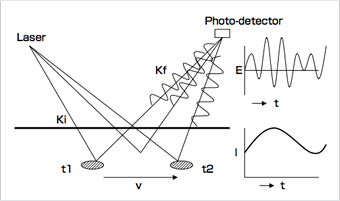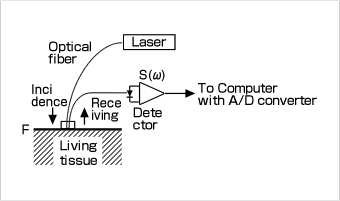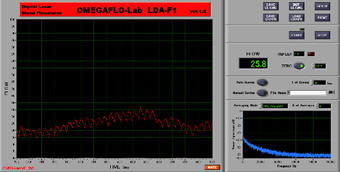When the RBC moves from the time t1 to t2 in the velocity (Fig. 2), V, in the tissue, the scattered light is shifted in frequency. However, the scattered light from the static tissue is not shifted in frequency, and its phase does not temporally change on the photo detector. Then, there is the discrepancy of the two phases on the photo detector. Also, when the RBC moves continuously, this discrepancy temporally changes. Therefore, the electric field, E, fluctuates by the summation of the scattered lights from many points, and the light intensity of the photo detector fluctuates, too (Ki andKf : wave vectors) .
The speed and the magnitude of the fluctuation are related to the velocity and the number density of RBCs respectively.
The simple theoretical equations are described below.
The vector of the laser light irradiated on a moving RBC is represented asKf、and the wave vector of the scattered light is represented as Ki. Here, Ki= (2πλ)・u and u is the unit vector. The electric field of the scattered light is expressed as
E = Eoexp[-i(Kf – Ki)・vt].
Here, Eois the electric field of the light irradiated on the moving RBC, and v is the vector of the velocity.
This equation shows that the phase component being in proportion to the velocity of the RBC is added on the original laser light. Also, the frequency shift, Δω, can be expressed as
Δω = (Kf – Ki)・v.
The laser tissue blood flowmeter using a fiber optic probe is treated as that the scattered lights from RBCs are Doppler shifted, but the instrument does not measure the Doppler shifted frequency itself. The detected light of the photo detector shows temporal fluctuation in the optical intensity, and tissue blood flow value is calculated from the intensity and the component of the fluctuation of the detected light as the normalized first moment of the power spectrum,
FLOW = ∫ωP(ω)dω(1)
Here, ω is angular frequency and P(ω) is the power spectrum of the detected light intensity.
The laser diode having 780 nm wavelength is used for measurement because the difference of the absorption between Oxy-Hb and Deoxy-Hb is small. The optical fibers in a probe are graded index fibers and the core diameter is 100 µm. The distance between the incidence and receiving of the standard contact type probe is 0.5 mm, and the measurement depth is about 1 mm from the surface.










